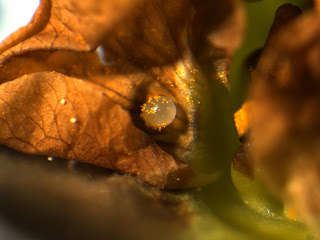I spent last Friday morning visiting a strawberry grower in Lee County, North Carolina who had noticed the first damage from strawberry clipper weevil (Anthanomus signatus) in his field on Thursday. Because his farm has a history of strawberry clipper, the grower had been scouting every other day and observed that damage went from zero to several clipped buds per plant in the 2 days since he last scouted.
Strawberry clipper weevil females lay their eggs in developing flower buds of strawberry, blackberry, raspberry, dewberry, and red bud. Female beetles then chew through the pedicel, which supports the flower bud. This causes the bud to drop from the plant. The larvae develop in the dropped flower bud over the course of 3 to 4 weeks. Adults emerge in mid summer, briefly feed on pollen and then overwinter. There is only one annual generation of strawberry clipper. Beetles overwinter in wooded areas, so fields located near the woods or rows closest to the woods often experience the greatest clipper injury.
 |
| Mating strawberry clipper weevils. Photo: Tom Murry, BugGuide. |
Rain in Lee County in Thursday had knocked many of the damaged buds off the strawberry plants, but there were still many plants with multiple clipped buds. I collected several damaged buds to take back to the lab and examine for eggs or larvae. On Friday, all I found were eggs, but by today (Monday), the buds contained quickly developing larvae.
 |
| Clipped strawberry buds (center). Photo: HJB |
|
 |
| Stawberry clipper egg inside strawberry blossom. Note oviposition hole to the upper left of the egg. The female weevil will chew a hole through the sepal and petals and then deposit the egg inside the flower. Females lay one egg per flower. Photo: HJB |
 |
| Strawberry clipper larva after 4 days in a 28C (82F) growth chamber. I was surprised to see how rapidly they had grown over the weekend! Photo: HJB |
The grower had treated the night before with Sevin XLR, a relatively "safe" pesticide to bees when dry. No pesticide is completely safe for bees; therefore, I do not recommend pesticide use during bloom if at all avoidable. If pesticides (insectides, fungicides, herbicides, or others) are necessary when flowers are present in fields, they should be applied in the evening, after bees are done foraging, to allow for the longest drying time possible before bees become active again.
See "A note on pesticide recommendations". The grower left 3, 15 ft sections near the edge of the field untreated for me to observe over the next few weeks. I placed yellow sticky traps to determine if we could trap beetles walking into the field and counted the damage on 10 plants per row. Of the 30 plants I observed, 11 had at least 1 clipped bud, and damage ranged from 1 to 5 buds per plant.
 |
| A recently clipped bud. Photo: HJB |
The big question in this case is whether treatment was necessary to prevent further strawberry clipper damage. Insecticides have been demonstrated to reduce adult clippers, and therefore the number of clipped buds. Research on the impact of clipper in New York (
English-Loeb, et al.1999,
subscription needed to view full article) found that all strawberry varieties tested compensated well for early season clipper damage, or in the words of the authors, damage to primary and secondary buds. Only damage in late season (tertiary) buds resulted in a significant yield loss because the the plant was not able to mature additional fruit. A closely related species has been studied in Europe in perennial strawberry plantings (
Aasen and Trandem 2006, subscription may be needed to view full article), where yield does appear to be improved when insecticides targeted to clippers are applied. I am not aware of any studies on compensation on Chandler, Camarosa, or Sweet Charlie, the strawberry varieties most commonly grown in North Carolina, so we cannot necessarily say if they will behave similarly to those observed in New York (Earliglow, Kent, Jewel, and Seneca). However, I think it seems likely that our varieties can and will compensate for early season clipper damage. For this reason, I believe that the thresholds currently recommended by entomologists in
Virginia (0.6 clipped buds per ft) or
New York (2 clipped buds per meter) are certainly conservative enough to prevent economic loss and are probably more conservative than necessary. Further work is needed on compensation in our key strawberry varieties as well as strawberry clipper biology in North Carolina.





No comments:
Post a Comment